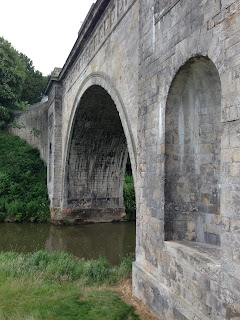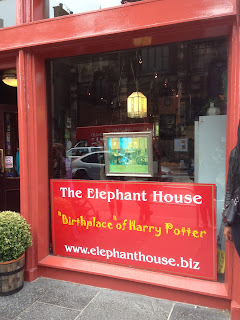This morning I got up a little ahead of schedule and ate a banana for breakfast while enjoying the view outside the house here at Dalkeith. Then another student and I decided to walk across the bridge in search of the Hairy Coo and just to see what else we could discover. Last night we had explored the house and found secret passage doors and rooms downstairs, so who knew what kinds of things we might find today!
 |
| Montagu Bridge |
 |
| View from Montagu Bridge |
 |
| Montagu Bridge from Below |
Our bus ride took just over a half hour, and then we did a little shopping before we headed to the National Library of Scotland for a self-guided tour of their exhibits. The first one I went through was the Jane Austen exhibit. It contained a first edition (in three volumes) of Pride and Prejudice from 1813, a dress, gloves, and other books and films that have modified the story in some way. There was also an area where visitors could leave their own comments and thoughts about the novel and the display.
Just beyond the Jane Austen exhibit, was the Picturing Africa display which had letters, journals, maps, paintings and drawings, and glass lantern slides from and relating to David Livingstone's time in Africa. This exhibit was of particular interest to me since I had just seen Livingstone's actual artifacts at the Royal Geographic Society last week. I enjoyed seeing his maps and trying to locate the different areas using the large magnifying glasses.
After looking around the National Library of Scotland, we passed by Greyfriars Bobby and learned the story of the pub and the statue. Apparently, there was a police constable who had a dog named Bobby. Bobby was a very loyal and protective dog, and he went everywhere with the police constable. The constable died one day, and the dog mourned his owner's death for fourteen years until his own death. There is now a statue and a pub named for Bobby.

After seeing Greyfriars Bobby, we headed out to see the Elephant House pub, which is where J.K. Rowling wrote much of the Harry Potter series. We took photos outside and then went to another nearby pub for lunch.
 |
| Where J.K. Rowling wrote Harry Potter |
 |
| The Elephant House window |
Following lunch on our own, we met up at the Duke of Wellington statue just outside of the National Records of Scotland building for our appointment there. On our way there, we saw Edinburgh Castle in the distance!
 |
| Duke of Wellington...with a bird on his head... |
The organization used to be known as the National Archives, but they just recently merged with the General Registrar and are now collectively known as the National records of Scotland. Their website is a portal that can link users to all of their different services and describe the different functions of each of the departments. Family history research is a huge part of their work, and researchers can do some of their searching from home by buying credits to gain access to the Scotland People website. On this website, researchers can search birth, death, and marriage records, census records, church and parish records, wills and testaments, and other business and legal documents. Since many of the documents are handwritten, there is even a website to help you read the Scottish handwriting, vocabulary, alphabet, etc. Check out the handwriting tutorial website for more information! If you still need more help and you're in the Edinburgh area, the NRS offers a night class about Scottish handwriting at Edinburgh University.
Tartans and plaids are a big deal in Scotland, and they are for sale in every shop on every street almost. However, if your family has a particular plaid, you want to make sure that it is authentic. The Scottish Register of Tartans will not only show you what tartans are available, but it will also allow you to register your own design if it meets the specifications.
If you know that your family is from a particular area of Scotland or you plan on visiting Scotland and you want more information about that area, you might want to try checking out the Scotland Places website which gives local history about counties, or shires, in Scotland.
The NRS maintains records that date from the 12th century, with the oldest item being a brieve from King David I from 1120s which grants land to build a church near Edinburgh Castle. Users access electronic material instead of the original in most cases. This means that they have had a huge push toward digitization in recent years, but even though much of their collection is digitized users can still only access the Virtual Volumes on site and not from home yet.
Formal registration began in 1855, so government records after that are much more complete than the church or parish records that precede them. Additionally, after 1855 the records would be kept in a standard format and not just in whatever way the church record-keepers felt like it. They have wills dating from the 1530s to the present and census records from 1841-1911.
Researchers coming in need a Reader's Ticket, which requires identification and two passport photographs. They must also follow a certain set of guidelines for using the Search Rooms (no pens, no food or drink, no cell phones or cameras, etc.). This ticket can be renewed every three years as needed. If you need material, you contact the librarians in advance so that they can locate the material and bring it from the other sites if necessary.
We got to see some of their more interesting records, such as a book of letters from 1513 between King Louis XII and King James of Scotland detailing their cooperation against the British. We also got to see a book of household accounts dating from 1673 that lists golf balls and golf clubs as some of the items the young master of the house needs to purchase along with wig powder and clothing. Another interesting item were maps and plans to improve Callendar that showed how they would divide up the new fews (plots) and the old fews on the acreage.
One item was particularly interesting to me because it was a receipt for a person's arrival to Accomack, VA. Apparently, people were sometimes sent to the United States not exactly by choice, but by "transportation" and upon arrival in the US, someone sent a letter (like the one we saw) back to Scotland noting their receipt.
On my way out of the NRS, I double-checked the books they have available for sale to see if McDaniel was listed under any of the McDonald clans. I had been unable to find it in any of the other books. Finally, I found it!!!!!! Yay! My father will be so excited! In fact, I was so excited that I did a little dance...right there in the lobby of the National Records of Scotland! After a little more shopping, my time in Edinburgh was complete for today and I headed back to Dalkeith for more adventures!
We stumbled upon the Dalkeith Library just as we got off the bus back in Dalkeith, so we decided to head in and see what it was like. The librarian was particularly friendly and told us all about the different things we could find on our walks at Dalkeith Palace. We grabbed another delicious dinner of minestrone soup and cheesy garlic bread (it was so yummy last night, I decided that I would do it again tonight!) and ate outside in the fresh air. Once we were finished with dinner we went on a quest to find the Hairy Coo! We passed fields and walked down paths and through brambles. We passed stables and found an orangerie. We crossed a bridge, and there it was--THE COO!! It was quite a shy coo, though. It kept turning away from us when we wanted to take his picture, but we found the hairy coo! He's quite adorable :) We stayed and watched the Hairy Coo for a while, and then we continued exploring. We found an old amphitheater and a rabbit. Here are some pictures from our adventure!
 |
| Orangerie |
 |
 |
| Hairy Coo!!!!!! (It's a Highland Cow, kind of like a Yak, I believe) |





No comments:
Post a Comment